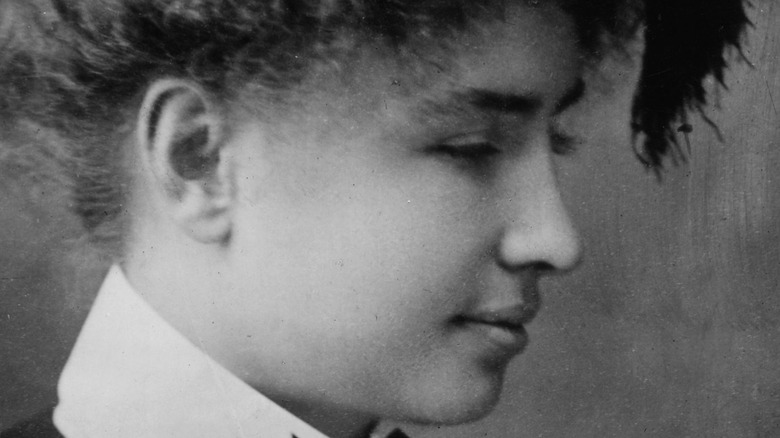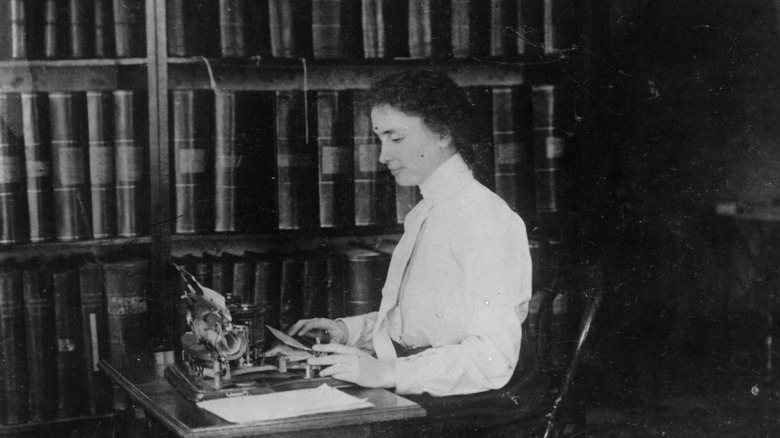A Look At The Time Helen Keller Flew A Plane Across The Sea
The story of Helen Keller has been a source of inspiration for people from all walks of life across the globe for over a century. Born in Tuscumbia, Alabama, on June 27, 1880, Keller's life was turned upside down when, at the age of just 19 months, she was struck by a mysterious illness which Britannica claims might have scarlet fever, but which other sources such as the journal Clinical Infectious Diseases (posted at the National Library of Medicine) speculate may also have possibly been a case of rubella, encephalitis, or meningitis.
Whatever the illness, the result was that the toddler was tragically rendered both blind and deaf, meaning that she would also likely never be able to learn to speak. The first years of Keller's life were dark and frustrating, but as a result of a meeting with the free-thinking inventor Alexander Graham Bell, her life was changed forever. Though he could not help Keller himself, Bell assigned to the young deaf and blind girl a teacher named Anne Sullivan, who was 20 years old, with experience teaching at Boston's Perkins Institution for the Blind (per Britannica).
In the coming years, Sullivan would teach Keller to sign and speak, to "hear" the speech of others through vibrations received through her fingertips on the speaker's face and neck, and to become a highly educated and effective activist for the rights of disabled people, along with a number of other causes. Keller was a shining ambassador for disabled excellence. Bold and fearless, in 1946 Keller accomplished what many believed to be impossible: flying a plane.
Helen Keller: plane fanatic
At the time of Helen Keller's ascension to the public eye in the first years of the 20th century, the capabilities of the deaf and blind were little appreciated. Such disabilities were spoken in the hushed tones of taboo; as Britannica notes, for many people of the previous century, blindness especially was associated with sexual impropriety and diseases such as syphilis.
Keller had already made headlines in the United States in relation to aviation back in 1919, back when commercial air travel was in its infancy. As reported in a newsreel shared on the YouTube Helen Keller Channel, Keller traveled by biplane for half an hour, later noting the incredible sense of "freedom" she felt as the sole passenger on the flight. Another journey in the 1930s also became famous. As reported in The New York Times, the writer and activist had traveled by plane from Newark Airport to a meeting with President Herbert Hoover. As the article describes, Keller was said to have been impressed with the plane itself, running her hands over the fuselage to gauge its size and shape, noting that the engine seemed to be "throbbing" with impatience and describing it as a "great, graceful bird."
Helen Keller takes the controls
However, Helen Keller's flight in 1946 was far more notable for one simple reason: she took the controls and piloted the aircraft single-handedly for around 20 full minutes. As recounted in an article titled "Wonderful Helen Keller Flies a 'Plane," which is posted as part of the Helen Keller Archive at the American Foundation for the Blind, this time Keller's destination was Scotland, where she arrived from Paris after a previous Mediterranean leg of the journey from Rome to the French capital.
Keller was traveling with her longtime secretary and assistant Polly Thompson, a sign language expert who took over from Anne Sullivan as Keller's closest companion after Sullivan's death in 1936. As the plane approached the Mediterranean Sea, the pilot relinquished control of the aircraft to Keller, who received instruction on piloting the plane through Thompson, who signed on the author's hand. Thompson recalled, "The 'plane crew were amazed at her sensitive touch on the controls. There was no shaking or vibration. She just sat there and flew the 'plane calmly and steadily." Keller herself called the experience "wonderful."

